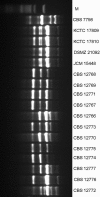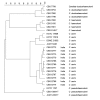New clonal strain of Candida auris, Delhi, India
- PMID: 24048006
- PMCID: PMC3810747
- DOI: 10.3201/eid1910.130393
New clonal strain of Candida auris, Delhi, India
Abstract
A new clonal strain of Candida auris is an emerging etiologic agent of fungemia in Delhi, India. In 12 patients in 2 hospitals, it was resistant to fluconazole and genotypically distinct from isolates from South Korea and Japan, as revealed by M13 and amplified fragment length polymorphism typing.
Keywords: AFLP; Candida auris; India; M13 fingerprinting; antifungal susceptibility; fungemia; fungi; parasitic diseases.
Figures


References
-
- White TJ, Bruns T, Lee S, Taylor J. Amplification and direct sequencing of fungal ribosomal RNA genes for phylogenetics. In: Innis MA, Gelfand DH, Sninsky JJ, White TJ, editors. PCR protocols: a guide to methods and applications. San Diego (CA): Academic Press; 1990. p. 315–22.
Publication types
MeSH terms
Substances
LinkOut - more resources
Full Text Sources
Other Literature Sources
Medical
Molecular Biology Databases
